Multi-Parameter Analysis of Groundwater Resources Quality in the Auvergne-Rhône-Alpes Region (France) Using a Large Database
Abstract
:1. Introduction
- Provide an overview of water quality at the appropriate scale (catchment, aquifer or administrative boundaries, on a regional or national scale);
- Identify trends in quality as early as possible;
- Link observed pollution patterns to land use in order to identify likely sources;
- Guide and support the design and implementation of programs of measures by providing appropriate data.
2. Materials and Methods
2.1. Auvergne-Rhône-Alpes Region
2.2. The Sise-Eaux Database
2.3. Data Conditioning
2.4. Principal Component Analysis
2.5. Parameters Hierarchical Clustering
2.6. Variograms and Kriging
3. Results
3.1. Parameters and Chemical Profiles Distribution
3.2. Diversity of Variograms
3.3. PCA Performed on Matrix M1
3.4. Subsection
- Major elements of lithological origin and electrical conductivity (EC, Ca, HCO3, SO4);
- K and Mg, which are related to this first group but showed a certain dissimilarity;
- Elements involved in redox processes (Fe, Mn, NO2, As);
- Na, Cl, NO3, and H+, which may be of mixed origin, both natural and anthropogenic.
4. Discussion
4.1. Parameters, Lithology and Major Structural Units
4.2. Mechanisms for Acquiring Characteristics
5. Conclusions
- Synthesise the essential information contained in the nearly 80% of information conveyed by 13 parameters. This represents a major dimensional reduction and a significant simplification of the water quality maps.
- Separate, in particular, the different components of spatio-temporal variations in water faecal contamination. This revealed at least 3 sources of variability in groundwater bacteriological quality:
- •
- The main component is linked to the intrusion of surface water by run-off during heavy rainfall events. This is a temporal variability, as it occurs mainly following storms at the end of the summer, but also a spatial variability, as only certain poorly protected catchments are vulnerable to faecal contamination.
- •
- The second component is more related to spatial variability: water with a calcium carbonate profile is less likely to generate faecal contamination, which can be attributed to the flocculent nature of the calcium ion on clay colloids, reducing the risk of solid transport and germs. The distribution of this mechanism, linked to the water chemical profile, is essentially due to lithological variability.
- •
- The third component also concerns the calcium carbonate environment, but anoxic waters that are fairly rich in iron and subject to contamination. It is also linked to spatial variability, concerning shallow areas where water stagnation favours reduced conditions and where the iron (ferric cements in the matrix) is solubilised.
Author Contributions
Funding
Data Availability Statement
Acknowledgments
Conflicts of Interest
References
- van der Gun, J. Chapter 24—Groundwater Resources Sustainability; Mukherjee, A., Scanlon, B.R., Aureli, A., Langan, S., Guo, H., McKenzie, A.A., Eds.; Elsevier: Amsterdam, The Netherlands, 2021; pp. 331–345. ISBN 978-0-12-818172-0. [Google Scholar]
- Yuan, H.; Yang, S.; Wang, B. Hydrochemistry characteristics of groundwater with the influence of spatial variability and water flow in Hetao Irrigation District, China. Environ. Sci. Pollut. Res. 2022, 29, 71150–71164. [Google Scholar] [CrossRef] [PubMed]
- Gao, Y.; Chen, J.; Qian, H.; Wang, H.; Ren, W.; Qu, W. Hydrogeochemical characteristics and processes of groundwater in an over 2260 year irrigation district: A comparison between irrigated and nonirrigated areas. J. Hydrol. 2022, 606, 127437. [Google Scholar] [CrossRef]
- Bhunia, G.S.; Shit, P.K.; Brahma, S. Chapter 19—Groundwater Conservation and Management: Recent Trends and Future Prospects; Shit, P., Bhunia, G., Adhikary, P., Eds.; Elsevier: Amsterdam, The Netherlands, 2023; pp. 371–385. ISBN 978-0-323-99963-2. [Google Scholar]
- Koundouri, P. Current Issues in the Economics of Groundwater Resource Management. J. Econ. Surv. 2004, 18, 703–740. [Google Scholar] [CrossRef]
- Kemper, K.E. Groundwater—From development to management. Hydrogeol. J. 2004, 12, 3–5. [Google Scholar] [CrossRef]
- Bradford, S.A.; Harvey, R.W. Future research needs involving pathogens in groundwater. Hydrogeol. J. 2017, 25, 931–938. [Google Scholar] [CrossRef]
- Xia, Q.; He, J.; Li, B.; He, B.; Huang, J.; Guo, M.; Luo, D. Hydrochemical evolution characteristics and genesis of groundwater under long-term infiltration (2007–2018) of reclaimed water in Chaobai River, Beijing. Water Res. 2022, 226, 119222. [Google Scholar] [CrossRef] [PubMed]
- Mogheir, Y.; Singh, V.P.; de Lima, J.L.M.P. Spatial assessment and redesign of a groundwater quality monitoring network using entropy theory, Gaza Strip, Palestine. Hydrogeol. J. 2006, 14, 700–712. [Google Scholar] [CrossRef]
- Farlin, J.; Gallé, T.; Pittois, D.; Bayerle, M.; Schaul, T. Groundwater quality monitoring network design and optimisation based on measured contaminant concentration and taking solute transit time into account. J. Hydrol. 2019, 573, 516–523. [Google Scholar] [CrossRef]
- Xiong, Y.; Luo, J.; Liu, X.; Liu, Y.; Xin, X.; Wang, S. Machine learning-based optimal design of groundwater pollution monitoring network. Environ. Res. 2022, 211, 113022. [Google Scholar] [CrossRef]
- Daughney, C.J.; Raiber, M.; Moreau-Fournier, M.; Morgenstern, U.; van der Raaij, R. Use of hierarchical cluster analysis to assess the representativeness of a baseline groundwater quality monitoring network: Comparison of New Zealand’s national and regional groundwater monitoring programs. Hydrogeol. J. 2012, 20, 185–200. [Google Scholar] [CrossRef]
- Flindt Jørgensen, L.; Villholth, K.G.; Refsgaard, J.C. Groundwater management and protection in Denmark: A review of pre-conditions, advances and challenges. Int. J. Water Resour. Dev. 2017, 33, 868–889. [Google Scholar] [CrossRef]
- Suk, H.; Lee, K.-K. Characterization of a Ground Water Hydrochemical System Through Multivariate Analysis: Clustering into Ground Water Zones. Groundwater 1999, 37, 358–366. [Google Scholar] [CrossRef]
- Chery, L.; Laurent, A.; Vincent, B.; Tracol, R. Echanges SISE-Eaux/ADES: Identification des Protocoles Compatibles Avec les Scénarios d’échange SANDRE; ONEMA, BRGM: Vincennes, France; Orléans, France, 2011. [Google Scholar]
- Gran-Aymeric, L. Un portail national sur la qualite des eaux destinees a la consommation humaine. Tech. Sci. Méthodes 2010, 12, 45–48. [Google Scholar] [CrossRef]
- Tiouiouine, A.; Yameogo, S.; Valles, V.; Barbiero, L.; Dassonville, F.; Moulin, M.; Bouramtane, T.; Bahaj, T.; Morarech, M.; Kacimi, I. Dimension reduction and analysis of a 10-year physicochemical and biological water database applied to water resources intended for human consumption in the provence-alpes-cote d’azur region, France. Water 2020, 12, 525. [Google Scholar] [CrossRef]
- Tiouiouine, A.; Jabrane, M.; Kacimi, I.; Morarech, M.; Bouramtane, T.; Bahaj, T.; Yameogo, S.; Rezende-Filho, A.; Dassonville, F.; Moulin, M.; et al. Determining the relevant scale to analyze the quality of regional groundwater resources while combining groundwater bodies, physicochemical and biological databases in southeastern france. Water 2020, 12, 3476. [Google Scholar] [CrossRef]
- Jabrane, M.; Touiouine, A.; Bouabdli, A.; Chakiri, S.; Mohsine, I.; Valles, V.; Barbiero, L. Data Conditioning Modes for the Study of Groundwater Resource Quality Using a Large Physico-Chemical and Bacteriological Database, Occitanie Region, France. Water 2023, 15, 84. [Google Scholar] [CrossRef]
- Mohsine, I.; Kacimi, I.; Abraham, S.; Valles, V.; Barbiero, L.; Dassonville, F.; Bahaj, T.; Kassou, N.; Touiouine, A.; Jabrane, M.; et al. Exploring Multiscale Variability in Groundwater Quality: A Comparative Analysis of Spatial and Temporal Patterns via Clustering. Water 2023, 15, 1603. [Google Scholar] [CrossRef]
- Barbel-Périneau, A.; Barbiero, L.; Danquigny, C.; Emblanch, C.; Mazzilli, N.; Babic, M.; Simler, R.; Valles, V. Karst flow processes explored through analysis of long-term unsaturated-zone discharge hydrochemistry: A 10-year study in Rustrel, France. Hydrogeol. J. 2019, 27, 1711–1723. [Google Scholar] [CrossRef]
- Jabrane, M.; Touiouine, A.; Valles, V.; Bouabdli, A.; Chakiri, S.; Mohsine, I.; El Jarjini, Y.; Morarech, M.; Duran, Y.; Barbiero, L. Search for a Relevant Scale to Optimize the Quality Monitoring of Groundwater Bodies in the Occitanie Region (France). Hydrology 2023, 10, 89. [Google Scholar] [CrossRef]
- Mohsine, I.; Kacimi, I.; Valles, V.; Leblanc, M.; El Mahrad, B.; Dassonville, F.; Kassou, N.; Bouramtane, T.; Abraham, S.; Touiouine, A.; et al. Differentiation of multi-parametric groups of groundwater bodies through Discriminant Analysis and Machine Learning. Hydrology 2023, 10, 230. [Google Scholar] [CrossRef]
- Lazar, H.; Ayach, M.; Barry, A.; Mohsine, I.; Touiouine, A.; Huneau, F.; Mori, C.; Garel, E.; Kacimi, I.; Valles, V.; et al. Groundwater bodies in Corsica: A critical approach to GWBs subdivision based on multivariate water quality criteria. Hydrology 2023, 10, 213. [Google Scholar] [CrossRef]
- Helena, B.; Pardo, R.; Vega, M.; Barrado, E.; Fernandez, J.M.; Fernandez, L. Temporal evolution of groundwater composition in an alluvial aquifer (Pisuerga River, Spain) by principal component analysis. Water Res. 2000, 34, 807–816. [Google Scholar] [CrossRef]
- Rezende Filho, A.; Furian, S.; Victoria, R.; Mascré, C.; Valles, V.; Barbiero, L. Hydrochemical variability at the upper paraguay basin and pantanal wetland. Hydrol. Earth Syst. Sci. 2012, 16, 2723–2737. [Google Scholar] [CrossRef]
- Day, W.H.E.; Edelsbrunner, H. Efficient algorithms for agglomerative hierarchical clustering methods. J. Classif. 1984, 1, 7–24. [Google Scholar] [CrossRef]
- Bouguettaya, A.; Yu, Q.; Liu, X.; Zhou, X.; Song, A. Efficient agglomerative hierarchical clustering. Expert Syst. Appl. 2015, 42, 2785–2797. [Google Scholar] [CrossRef]
- Cressie, N. The origins of kriging. Math. Geol. 1990, 22, 239–252. [Google Scholar] [CrossRef]
- Aiuppa, A.; Allard, P.; D’Alessandro, W.; Michel, A.; Parello, F.; Treuil, M.; Valenza, M. Mobility and fluxes of major, minor and trace metals during basalt weathering and groundwater transport at Mt. Etna volcano (Sicily). Geochim. Cosmochim. Acta 2000, 64, 1827–1841. [Google Scholar] [CrossRef]
- BRGM 544E—Calcaires et Marnes Crétacés et Jurassiques de la Vallée du Rhône, du Diois et des Baronnies. Available online: https://www.rhone-mediterranee.eaufrance.fr/sites/sierm/files/content/waterbody_hydrogeological_documents/Fiches/544E.pdf (accessed on 28 November 2023).
- Boithias, L.; Choisy, M.; Souliyaseng, N.; Jourdren, M.; Quet, F.; Buisson, Y.; Thammahacksa, C.; Silvera, N.; Latsachack, K.; Sengtaheuanghoung, O.; et al. Hydrological Regime and Water Shortage as Drivers of the Seasonal Incidence of Diarrheal Diseases in a Tropical Montane Environment. PLoS Neglected Trop. Dis. 2016, 10, e0005195. [Google Scholar] [CrossRef]
- Onifade, O.; Shamsuddin, N.; Teck Ching Lai, D.; Jamil, H.; Gödeke, S.H. Importance of baseline assessments: Monitoring of Brunei River’s water quality. H2Open J. 2023, 6, 518–534. [Google Scholar] [CrossRef]
- Pachepsky, Y.A.; Shelton, D.R. Escherichia coli and Fecal Coliforms in Freshwater and Estuarine Sediments. Crit. Rev. Environ. Sci. Technol. 2011, 41, 1067–1110. [Google Scholar] [CrossRef]
- Le, H.T.; Pommier, T.; Ribolzi, O.; Soulileuth, B.; Huon, S.; Silvera, N.; Rochelle-Newall, E. Overland flow during a storm event strongly affects stream water chemistry and bacterial community structure. Aquat. Sci. 2021, 84, 7. [Google Scholar] [CrossRef]
- Andrade, L.; Boudou, M.; Hynds, P.; Chique, C.; Weatherill, J.; O’Dwyer, J. Spatiotemporal dynamics of Escherichia coli presence and magnitude across a national groundwater monitoring network, Republic of Ireland, 2011–2020. Sci. Total Environ. 2022, 840, 156311. [Google Scholar] [CrossRef] [PubMed]
- Abbas, A.; Baek, S.; Silvera, N.; Soulileuth, B.; Pachepsky, Y.; Ribolzi, O.; Boithias, L.; Cho, K.H. In-stream Escherichia coli modeling using high-temporal-resolution data with deep learning and process-based models. Hydrol. Earth Syst. Sci. 2021, 25, 6185–6202. [Google Scholar] [CrossRef]
- John, D.E.; Rose, J.B. Review of Factors Affecting Microbial Survival in Groundwater. Environ. Sci. Technol. 2005, 39, 7345–7356. [Google Scholar] [CrossRef]
- Pandey, P.K.; Kass, P.H.; Soupir, M.L.; Biswas, S.; Singh, V.P. Contamination of water resources by pathogenic bacteria. AMB Express 2014, 4, 51. [Google Scholar] [CrossRef]
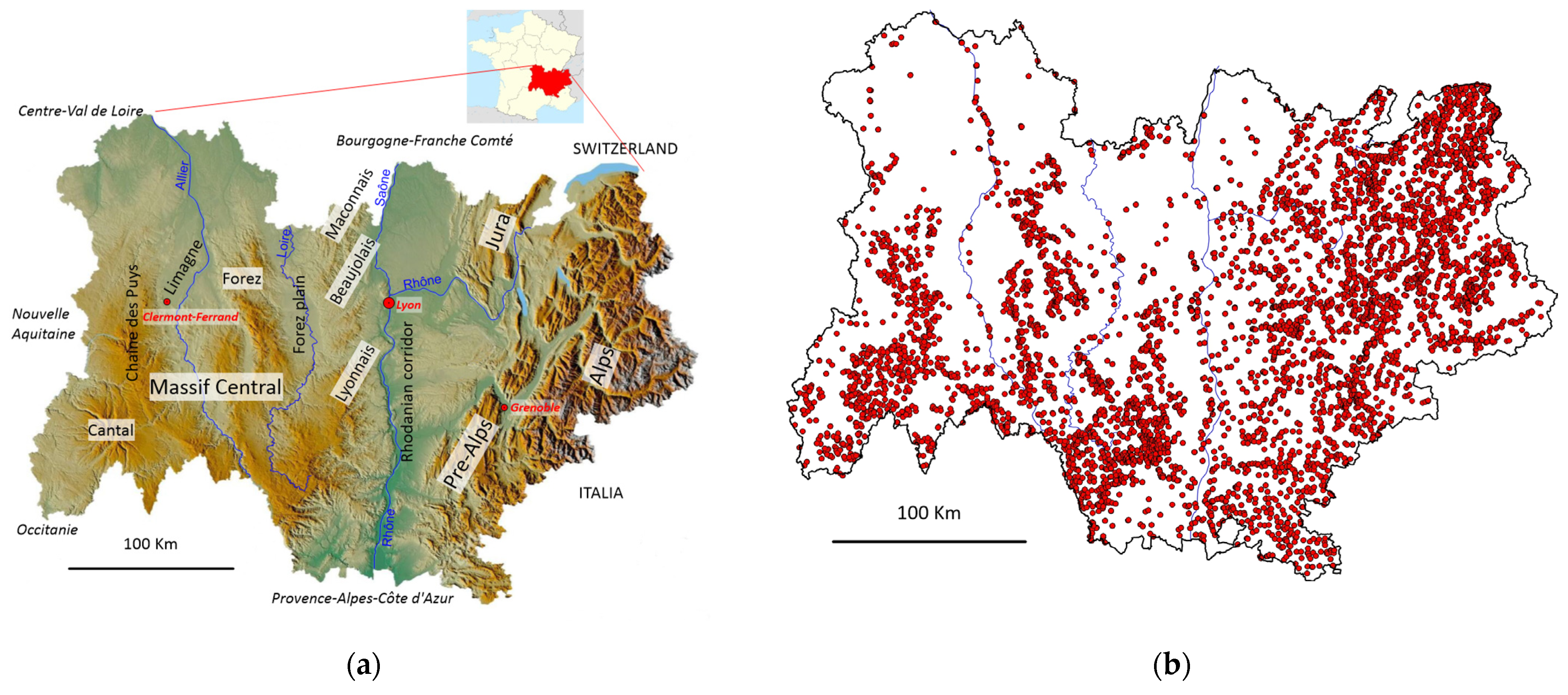
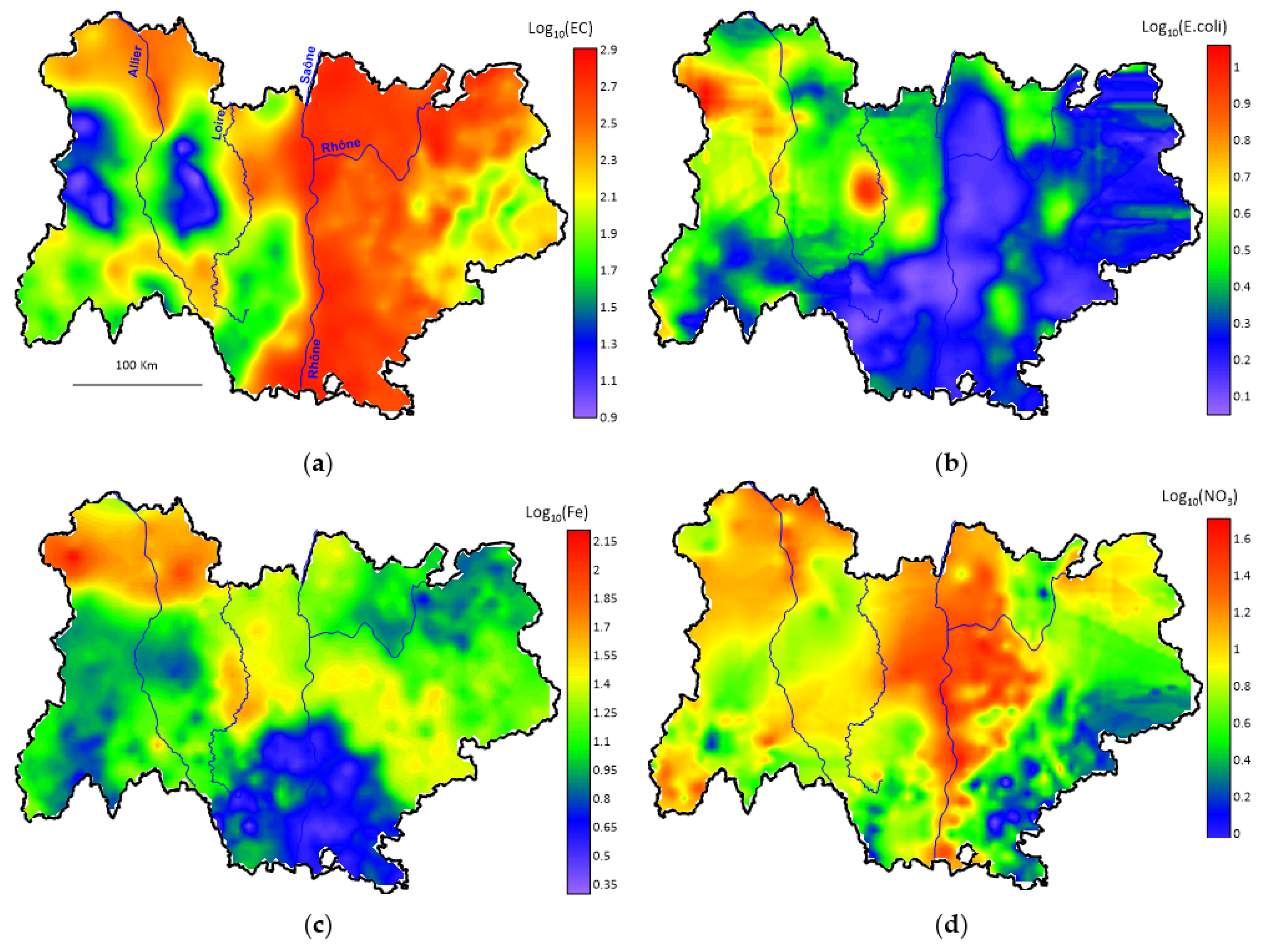

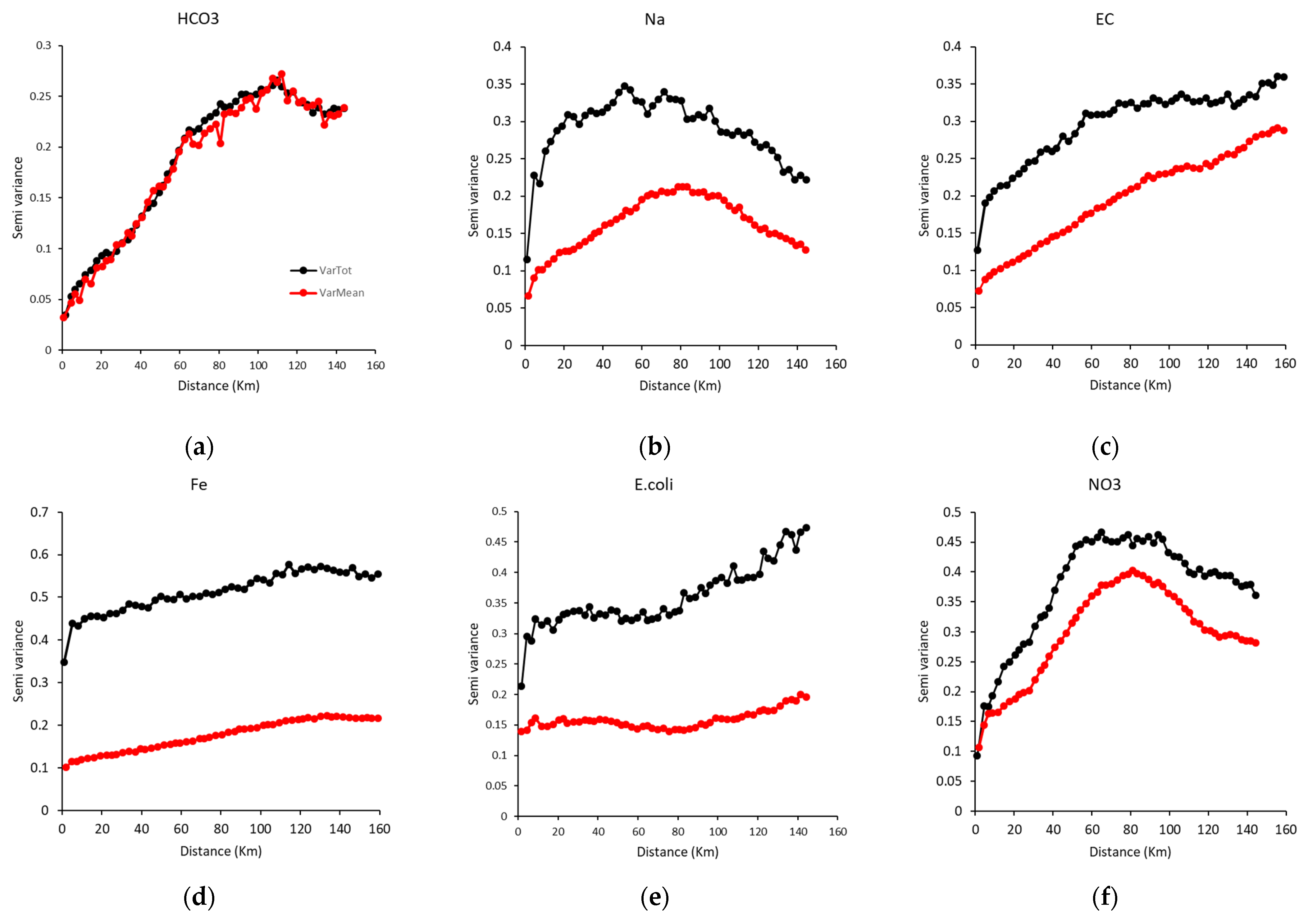
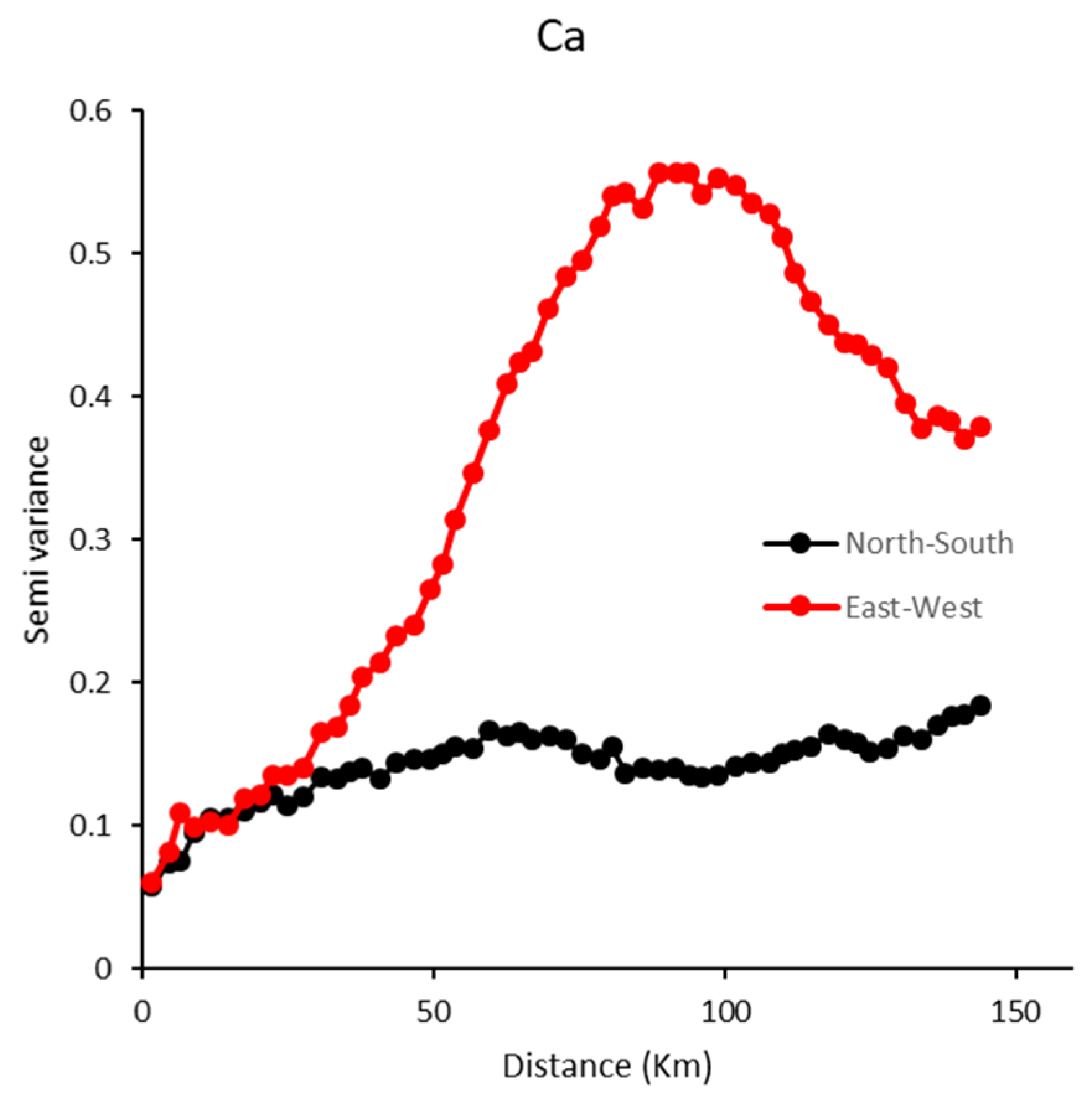
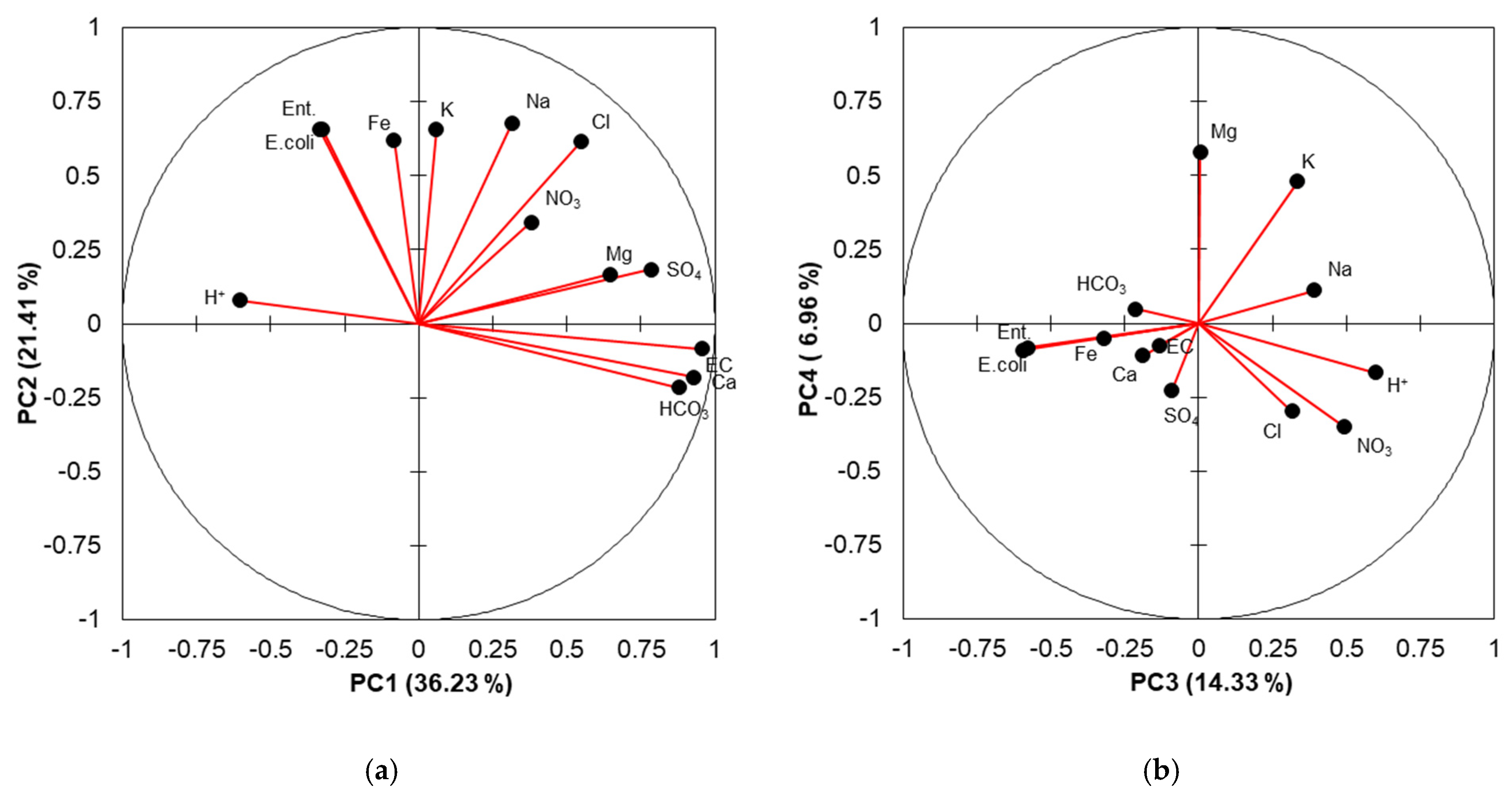

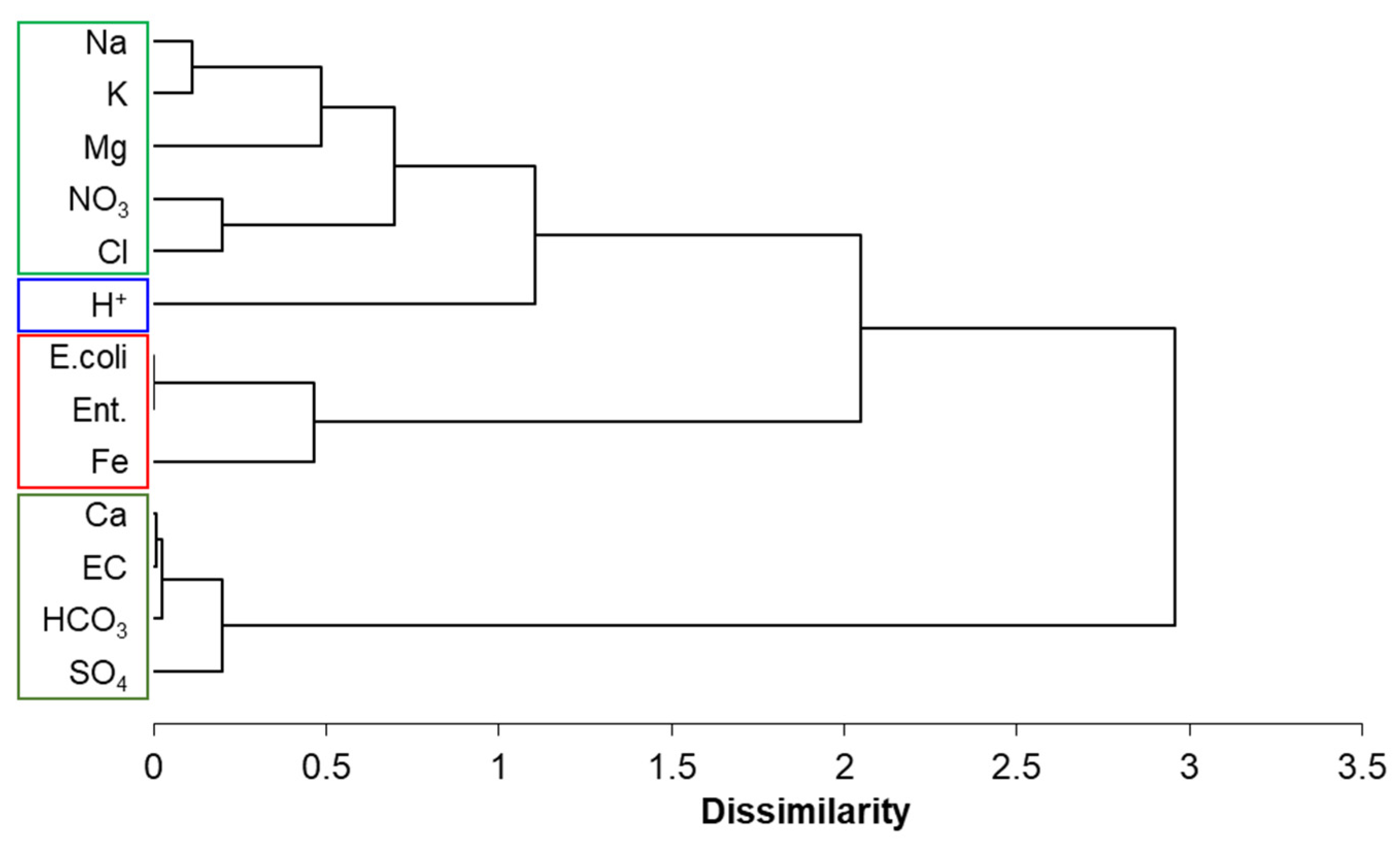
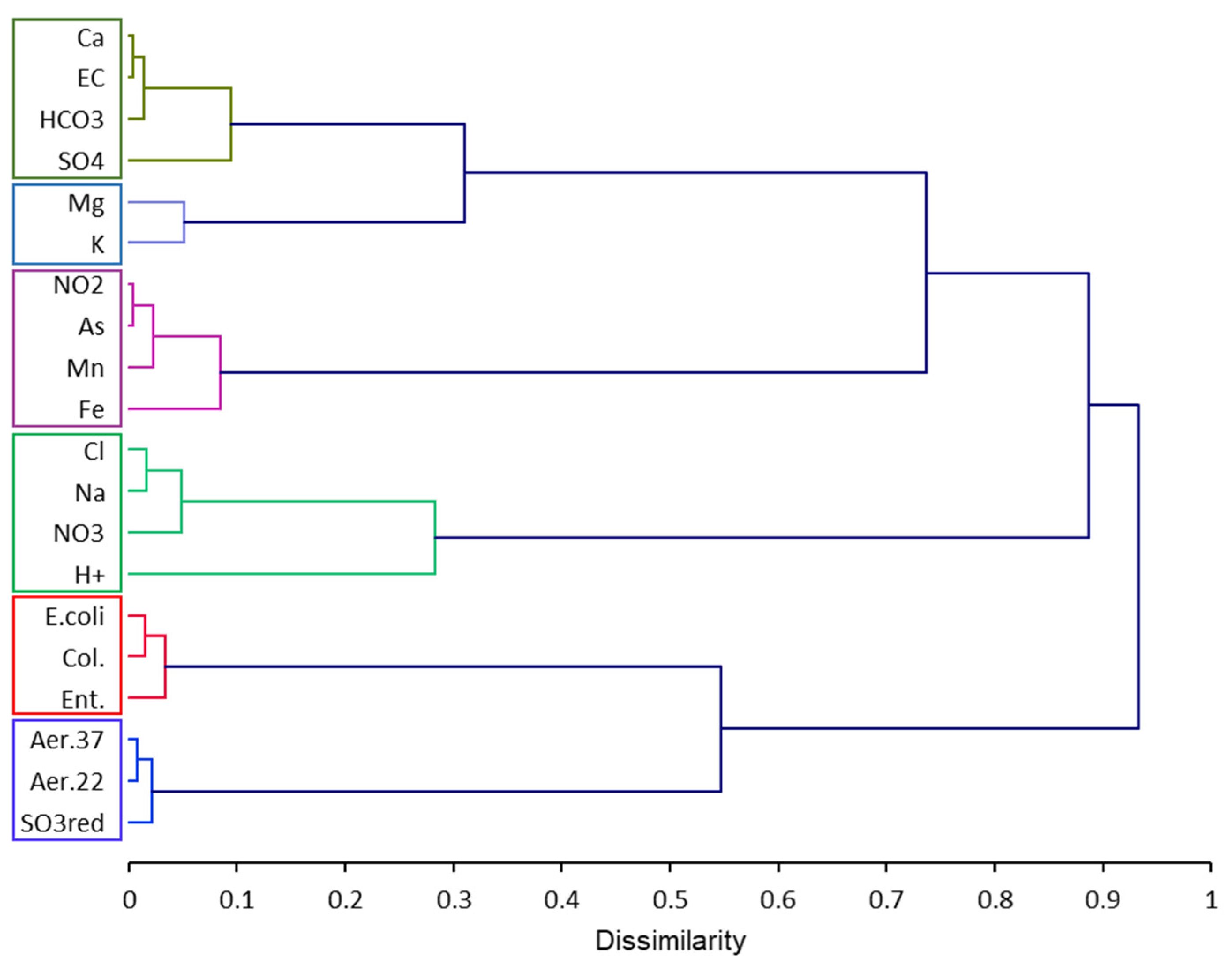
| PC1 | PC2 | PC3 | PC4 | PC5 | PC6 | PC7 | |
|---|---|---|---|---|---|---|---|
| Eigenvalue | 4.71 | 2.78 | 1.86 | 0.91 | 0.71 | 0.62 | 0.41 |
| Variability (%) | 36.23 | 21.41 | 14.33 | 6.96 | 5.44 | 4.73 | 3.16 |
| Cumulative % | 36.23 | 57.64 | 71.97 | 78.93 | 84.37 | 89.1 | 92.26 |
| PC1 | PC2 | PC3 | PC4 | PC5 | PC6 | |
|---|---|---|---|---|---|---|
| Ent. | −0.334 | 0.657 | −0.579 | −0.084 | −0.254 | −0.104 |
| E. coli | −0.324 | 0.655 | −0.594 | −0.092 | −0.241 | −0.099 |
| EC | 0.956 | −0.085 | −0.132 | −0.074 | −0.023 | 0.060 |
| H+ | −0.602 | 0.080 | 0.598 | −0.166 | 0.049 | −0.023 |
| K | 0.060 | 0.657 | 0.334 | 0.479 | −0.005 | 0.200 |
| Na | 0.314 | 0.676 | 0.390 | 0.112 | 0.133 | −0.377 |
| Ca | 0.929 | −0.181 | −0.189 | −0.109 | −0.019 | 0.070 |
| Mg | 0.646 | 0.168 | 0.006 | 0.580 | −0.176 | −0.004 |
| Cl | 0.547 | 0.614 | 0.315 | −0.297 | 0.062 | −0.141 |
| SO4 | 0.784 | 0.184 | −0.090 | −0.225 | 0.266 | −0.197 |
| HCO3 | 0.878 | −0.215 | −0.213 | 0.049 | −0.059 | 0.044 |
| Fe | −0.084 | 0.620 | −0.322 | −0.049 | 0.504 | 0.458 |
| NO3 | 0.379 | 0.343 | 0.494 | −0.350 | −0.448 | 0.364 |
Disclaimer/Publisher’s Note: The statements, opinions and data contained in all publications are solely those of the individual author(s) and contributor(s) and not of MDPI and/or the editor(s). MDPI and/or the editor(s) disclaim responsibility for any injury to people or property resulting from any ideas, methods, instructions or products referred to in the content. |
© 2023 by the authors. Licensee MDPI, Basel, Switzerland. This article is an open access article distributed under the terms and conditions of the Creative Commons Attribution (CC BY) license (https://creativecommons.org/licenses/by/4.0/).
Share and Cite
Ayach, M.; Lazar, H.; Bousouis, A.; Touiouine, A.; Kacimi, I.; Valles, V.; Barbiero, L. Multi-Parameter Analysis of Groundwater Resources Quality in the Auvergne-Rhône-Alpes Region (France) Using a Large Database. Resources 2023, 12, 143. https://doi.org/10.3390/resources12120143
Ayach M, Lazar H, Bousouis A, Touiouine A, Kacimi I, Valles V, Barbiero L. Multi-Parameter Analysis of Groundwater Resources Quality in the Auvergne-Rhône-Alpes Region (France) Using a Large Database. Resources. 2023; 12(12):143. https://doi.org/10.3390/resources12120143
Chicago/Turabian StyleAyach, Meryem, Hajar Lazar, Abderrahim Bousouis, Abdessamad Touiouine, Ilias Kacimi, Vincent Valles, and Laurent Barbiero. 2023. "Multi-Parameter Analysis of Groundwater Resources Quality in the Auvergne-Rhône-Alpes Region (France) Using a Large Database" Resources 12, no. 12: 143. https://doi.org/10.3390/resources12120143





